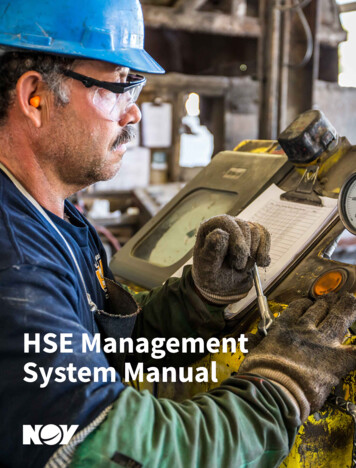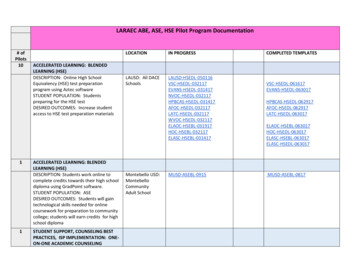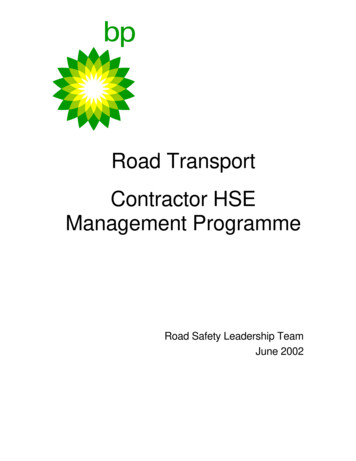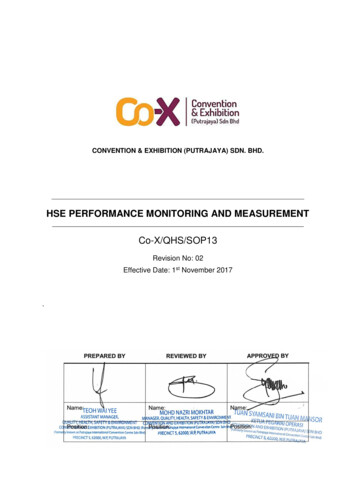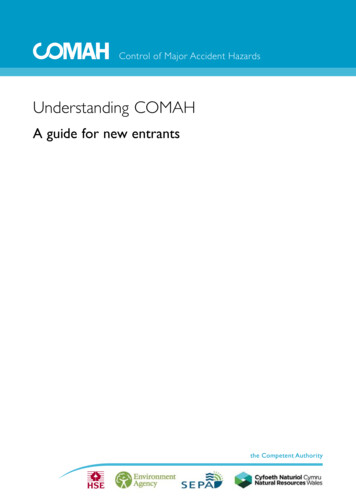
Transcription
A report about the HSE investigation into the collapse of atower crane in Canada Square London E14, on 21 May 2000
Main ReportBrief summary1)On Sunday 21 May 2000 at approximately 4:00pm the top section of a Wolff 320BF tower crane overturned at Canada Square, London, E14. Two members of theerection crew and the crane driver working on this tower crane were killed as a result.Two other erectors working with them on the crane survived, as did an assistant on theground. The erection crew had been using an auxiliary device known as climbing gearto raise the height of the crane. The top of the crane and the climbing gear fell about 120metres to the ground below, across an adjacent site and public road towards a pavedarea outside the Canary Wharf tower at No. 1 Canada Square. No one on the groundwas injured, partly because the road outside had been closed temporarily.Site details2)The construction project involved the building of a 44-storey office block (plus rooflevel and 4 basement levels) for the Hong Kong and Shanghai Bank Corporation. It wasone of several major construction projects in the Canary Wharf area at that time. Thesite, designated as DS2, was situated between North Cofferdam Road and NorthColonnade off Canada Square, London E14. The finished building shell had a concretecore containing lift shafts, stairways and services. The perimeter structure was steelframed with poured concrete floors. By 19 May the ‘jump form’ core had reached level30 (about 145 metres above ground level) at its highest point. The steel frame was upto level 19 (about 100 metres above ground level). The highest level that had been fullydecked out for concreting was at level 16. Hollow rib decking had been installed on partof level 19.3)There were several tower cranes on the DS2 site and the adjacent site (designatedas DS1). This neighbouring site was at ground slab level, with basement levels belowthat. Another site, designated DS5, located on the other side of Canada Square hadreached a similar height to DS2.Details of deceased persons4)Those who died were all employees of Hewden Tower Cranes Ltd: Michael Whittard, erection supervisor Peter Clark, tower crane driver Martin Burgess, member of the erection crew2
Key duty holders involved5)The main parties involved in the construction work at DS2 and associated craneactivities were:Manufacturer and supplier of equipmentMan Wolffkran GmBH of Heilbron, Germany (referred to as ‘Wolff’ in this report)Crane erection company/employerHewden Tower Cranes Limited (referred to as ‘Hewdens’ in this report) of Castleford,West Yorkshire, WF10 then a member of the Hewden Stuart Group (but no longertrading).Steel erection sub-contractor contracting crane companyKvaerner Cleveland Bridge, Yarm Road, Darlington, Co Durham DL1 (referred to as‘KCB’ in this report). They were working with Byrne Brothers (Formwork) Ltd. ofWhitehart Lane, Barnes, London SW13) who focused more on the reinforced concreteaspects of the construction project.Principal contractorCanary Wharf Contractors Ltd (referred to as ‘CWCL’ in this report) of One CanadaSquare, Canary Wharf, London E14Plant involvedThe crane6)The crane involved was a Wolff 320 BF luffing jib tower crane (fitted with a 50metre jib) manufactured and supplied by Man Wolffkran (Figure 1 shows typical Wolffluffing jib cranes on the DS1/DS2 sites after the incident). A luffing jib crane has a jibthat can be raised or lowered by varying its angle. This alters the radius of the crane,that is the horizontal distance between the crane hook and the centre of the mast.7)The crane was designated as site tower crane number 3 (TC 3). It was located atthe north west corner of the DS2 site. The main parts of the crane were manufactured in1999 and the crane was first erected on site in August 1999. TC3 was last subjected toa periodic thorough in-service examination in September 1999 by an independentcompetent person while erected at DS2. It was one of five Wolff tower cranes erectedon the DS2 construction site by Hewdens. A similar tower crane designated site towercrane 2 (TC2) had been erected on the south east side of DS2. The tallest tower crane3
on site, designated tower crane 1 (TC1) had been erected within the concrete core ofthe building. TC2 was fitted with an anemometer but TC3 was not. Reliance seems tohave been placed on radio communications between crane drivers on matters such aswind speed.8)The vertical mast of TC3 was made up largely of TV 20.4 tower sections that werepinned end to end. A typical TV 20.4 mast section is 2 metres square and 4.5 metrestall. The sections are connected together by a male spigot and female socketarrangement. At the top of each leg of a mast section there is a male spigot 350mmlong and 140mm square in cross-section. This engages in the female socket on thebottom of the mating leg of the mast section above. To allow the spigot to engage in thesocket there is a horizontal clearance of approximately 7mm between each part.Spigots and sockets have two corresponding holes for pinning these sections securelytogether. Eight steel pins, two at each leg, are driven into place after each new sectionis added to a mast. When pinned there should be a gap of about 10mm between theshoulder of the spigot and the base of the socket. The end of a pin is normally fitted witha retaining clip, referred to as an R-clip, to stop the pins working out of the mast section.9)Two climbing lugs, referred to as catch hooks, are welded to the upper part of oneface of the mast sections. There were two slightly different designs of catch hookprovided on the mast sections of TC3. One design included a vertical hole; the otherversion included a slot. Figure 2 shows the top of a TV20.4 mast section and the catchhooks. As the mast height increased at the DS2 site, building ties were used to securethe mast to the adjacent structure at regular intervals.10) The crane slewing module is at the top of the mast. On the underside of thismodule is a short mast head section attached to the top of the mast by the same pinnedspigot and socket arrangement used for the crane mast sections. The slewing modulecontains a large internal ring gear and motor that is used to rotate or slew the top of thecrane in a horizontal plane. Fixed to the top of the slewing module is the luffing jib, thecounterbalance jib, the A-frame that carried the luffing ropes to enable the driver to varythe angle of the jib, the control equipment and driver’s cab.4
The climbing gear11) At the time of the incident the crane was fitted with a Wolff KWH 20.5 detachablehydraulic exterior climbing gear approximately 9.3 metres high. Wolff supplied theclimbing gear to Hewdens in 1997. The purpose of this device was to enable theerectors to insert new mast sections on top of the existing crane mast, thereby raisingthe working height of the crane.12) The main structure of a KWH 20.5 climbing gear (referred to hereafter simply as‘the climbing frame’) consists of front and back climbing frame sections bolted verticallytogether around the mast of the crane. The principal uprights of the climbing frame arefabricated from hollow rectangular steel sections 120mm square. The lower part of theclimbing frame is fitted with two sets of four 226mm diameter grooved guide wheels.The lowest set are fitted to the base of the frame and the upper set are fitted 3.25mabove that. The frame moves up and down the top mast section of the crane guided bythese wheels. They run on the corners of the mast sections when in use. They areintended to keep the frame in line with the mast of the crane. Nominally there should be2mm clearance between the wheels and the mast legs. They transmit any forces actingon the frame onto the mast.13) The frame contains a long stroke hydraulic cylinder mounted vertically at the rear.This performs the lift. Power to the hydraulic motor is intended to be supplied via aspecial socket in an electrical panel on the machine deck. When used, this shouldprevent the crane driver from slewing or luffing the crane during the use of the hydrauliccylinder.14) A piston rod protrudes down from the hydraulic cylinder in the climbing frame andis attached to a horizontal cross head - referred to as the ‘yoke’ - by a large swivelbearing. This ‘yoke’ appears to have two short ‘arms’ protruding from the top on eachside. The yoke isn’t positively attached to the mast. There are two short weldedlocating spigots projecting down from the underside of each ‘arm’. These engage inholes in the catch hooks welded to the rear legs of the mast. They help ensure that theyoke sits in the correct position. The catch hooks act as reaction points for the hydraulicpiston rod enabling it to exert an upward force and lift the top of the crane whenrequired. The catch hooks on a mast section slope downwards towards the middle of itsrear face. This helps to centralise the yoke as it engages on the mast.5
15) The hydraulic cylinder is fitted with a special trolley on steel wheels (the pistontraverse carriage). This trolley can be moved backwards and pinned in place by a30mm diameter steel pin to avoid the cylinder fouling the catch hooks and otherprojections on the mast when the cylinder rod is retracted. The steel pin is moved to theother side of the cylinder to hold it towards the mast during a climbing operation.16) On the front face of the climbing frame there is a platform (traverse carriageplatform) on which each new mast section has to be located. Above the platform thereis a large opening in the climbing frame to allow the erection crew to insert the newtower section. The new mast section sits on a carriage (sometimes referred to as ‘thetray’) with four small wheels located on the platform and is moved through the openingat the appropriate point of the climbing operation. The wheels run on rails built into theclimbing frame.17) The climbing frame is equipped with upper and lower working platforms to facilitatefitting and operation. When required for use, the climbing frame is lifted into place andattached to the underside of the slewing module (mast head section) by steel pins.When assembled but not in use the climbing frame is usually detached from the masthead and parked above the highest tie to the structure. Figure 3 gives a schematicexplanation of the climbing frame key parts; Figure 4 illustrates the arrangement of theguide wheels on the corner of a mast leg.18) The climbing frame was not erected on TC3 in September 1999 when that towercrane was thoroughly examined by an independent competent person. It latertranspired that no certificate of thorough examination was available for the climbingframe. Also, no maintenance records for the device have been available for inspection.Tower cranes 2 and 3 were first climbed using the climbing frame in January 2000.Further climbs took place in February, March and April. The erection supervisor testedthe crane and issued a certificate (after completing these climbing operations) indicatingthat the crane was ready to be brought back into use.Description of the tower crane climbing operation19) Figures 5-7 show a typical Wolff luffing jib tower crane and climbing frame during aspecial demonstration climbing operation arranged by Hewdens at HSE’s request; keyparts are labelled. The models of crane and climbing frame used for the demonstration6
were similar to those involved in the incident at Canada Square (but different models)and the mast height was kept as short as practicable.20) To ‘climb’ the crane a gap of more than 4.5 metres has to be created between theupper part of the crane mast and the top of the crane. At the start of the operation, thenew mast section to be inserted is lifted up and placed on a platform projecting from theclimbing frame in readiness. When a sufficient gap has been created by extending thehydraulic piston rod the new mast section is rolled into that gap (Figure 7) and attachedto the crane top (mast head). Then it is lowered onto the top of the existing mast byretracting the hydraulic piston rod and pinned to the existing mast.Erecting the climbing frame21) The rear half of the climbing frame is lifted in place by the crane and secured to thelower part of the tower top. The second half is then lifted, secured to the tower top andthe two halves are then pulled together with a chain block and bolted. The tolerancesare tight; in particular the manufacturer has indicated that, when new, there is 2mm gapbetween the guide wheels and the mast. Erectors reported that they sometimesstruggled to bring together and bolt the two halves. If one of the bottom set of guidewheels was slightly off the corner of the mast (say 4-5mm) force would sometimes beused to move it into place.Locating the climbing frame onto the catch hooks and taking into operation22) At the start of each climbing stage the yoke is adjusted so that the spigotsprojecting from the underside of the yoke arms are positioned into the holes or slots ofthe catch hooks at the rear of the mast. The adjustment is made by extending orretracting the hydraulic cylinder piston rod and pulling the cylinder assembly towards themast so that the spigots seat properly in the catch hooks (see Figure 8). The hydraulicpiston traverse carriage should then be pinned to lock it in position close to the mast.Lifting a new mast section to the climbing frame23) The new mast sections to be inserted are stood vertically in a convenient positionon the ground below. The crane is used to lift a new mast section onto the traversecarriage of the platform projecting from the front of the climbing frame (see Figure 6).7
‘Balancing’ the crane24) The jib is then checked, if necessary, to ensure it is square with the mast (jibpointing directly forwards) and the slewing drive brake engaged; the crane should not beslewed during the climbing operation while the piston rod is extended. The angle of thecrane jib is then adjusted to set the crane at the typical ‘balancing’ radius for the crane.This is the approximate position at which the forward overturning moment is balanced bythe backwards overturning moment. When climbing, the balance point for the crane islocated at the rear of the mast in a vertical line through the hydraulic cylinder.25) With saddle (horizontal) jib tower cranes the balancing operation is carried outusing a balance weight suspended from the crane hook attached to a trolley that runs onthe jib of the crane. If a luffing jib crane is to be climbed it is possible to use the selfweight of the crane jib (including the hoist rope and hook block) to balance the craneinstead. Therefore, a luffing jib crane like the Wolff 320BF need not be balanced with abalance weight. If no balance weight is used the jib radius will need to be greater than ifa balance weight had been suspended from the crane hook. The manufacturer’sinstructions were geared towards the use of a balance weight. However, the generalpractice at DS2 was not to deploy a balancing weight when climbing cranes. There wasno advice in the manufacturer’s manual on the typical radius for balancing the cranewithout a balance weight (see paragraph 127).26) The pins joining the top of the mast to the mast head under the slewing modulehave to be removed by hammer. The practice is to assess the ‘balance’ of the crane bychecking the alignment of the spigots on top of the mast and the sockets of the masthead as the hydraulic piston rod was extended by a small amount. The control lever forthe up/neutral/down valve of the hydraulic cylinder unit is operated from the top accessplatform. Checks are then made on all four corners of the mast. If the erectors judgethat the two sections were vertically aligned (free float) the crane was considered to be‘balanced’ and climbing could begin. If they were not exactly aligned – that is with thesocket rubbing on the spigot - the process would start again. The radius of the cranewould be adjusted by luffing the jib up or down and the erectors would raise the cranetop slightly to re-assess balance. When the erectors judged the spigots and sockets tobe aligned they would assume the crane was balanced.8
27) The exact balancing radius will be affected by conditions on the day including: the existence of local wind effects including speed and direction the verticality of the mast (which changes with the height above the last building tie) variations in judgments about the correct alignment of the top mast section and cranetop (mast head) frictional forces.28) The manufacturer’s manual advised that the climbing frame might only be used inwind speeds up to 45 km per hour (approximately 28 miles per hour). Hewdens haddecided to work to a lower maximum wind speed of 20 mph, although there appeared tobe some confusion among the erectors about this. In practice, this wind speed couldonly be taken into account at the start of a climb, before the crane top was separatedfrom the mast. Both wind speed and direction are likely to vary during a climbingoperation.29) As the free height of the crane increases above the highest tie to the structure themast tends to lean backwards because the hydraulic cylinder is at the rear. The higherthe crane above the topmost tie the greater the degree of lean: this will affect the radiusat which the crane is balanced.30) ‘True’ balance would ensure that the forward overturning moment is exactlybalanced by the backwards overturning moment of the crane. In this position, the forceacting on the guide wheels should, in theory, be zero. The balance changes during theclimbing operation, e.g. as the new mast section is moved into the gap in the climbingframe. When the supervisor is satisfied that the crane is balanced the crane driver ismeant to switch off power to the slewing motor and luffing motor.Raising the hydraulic piston rod for climbing31) The hydraulic piston rod is then extended, lifting the top of the crane to create anopening large enough to admit the new mast section. The gap created between the topof the mast and the mast head below the slewing module is now approaching 5 metres.The lift takes around 20 minutes and would normally be done in one continuousextension of the piston rod.9
Inserting the new mast section32) One of the erection crew then goes out onto the traverse carriage platform andpulls the new mast section on its tray into the gap created. The piston rod is then slowlyretracted to lower the four sockets of the mast head onto the spigots of the new mastsection. As a consequence, the tray holding the new mast section tends to sit down onthe spigots at the top of the crane mast – there are pockets on the underside of the tray.Four temporary hardened steel pins should then be inserted to suspend the new mastsection from the top of the crane (the mast head section). The piston rod is thenextended again to lift the new mast section clear of the tray. The temporary pins areslightly smaller than the 70mm diameter permanent pins and have a convenient handle.However, a practice had developed among some of the Hewdens crews to use shortlengths of scaffold tube about 18 inches in length and 50mm in diameter. The intentionwas to provide greater freedom of movement for the new mast section when suspendedfrom the crane top before making a permanent connection to the mast.33) The tray is then withdrawn and pinned back to the front platform. The new sectionis now being suspended from the underside of the mast head roughly 0.5 metres abovethe top of the mast. The next stage is to lower the top of the crane again so the socketson the underside of the new section engage with the four spigots on top of the mast.The new section is then secured with eight permanent pins. The temporary pins at thetop of the section also need to be replaced.Preparing for a new climb34) Each climbing or jacking procedure for each new mast section added takes about1¼ hours from start to finish under normal conditions. Before the procedure can berepeated, the yoke must be seated on the next set of catch hooks. The yoke assemblyattached to the end of the piston rod is moved out horizontally, clear of the mast, toprevent it fouling any projections. The piston rod is then fully retracted back into thehydraulic cylinder to raise the yoke up to the next set of catch hooks. When the yokehas been seated on these higher catch hooks and the upper fixings checked, the cranecan be slewed - if necessary - to pick up the next mast section.10
BackgroundCircumstances leading up to the incident35) By 18 May 2000 the steelwork erected around the core of building DS2 hadreached above the 19th level, just below tower cranes TC 2 (at the SE corner of DS2)and TC3 (at the NW corner of DS2). As one of the main functions of these cranes wasto lift steel beams and columns for the steel erection sub-contractor, the height of thecranes had to be raised to enable the contractor to continue work. TC1, positionedinside the central concrete core also had to be raised in height.36) A climb was arranged for TC2 and TC3 over the weekend of 20 and 21 May, withsome preparatory work to be done on the Friday. Hewdens erectors had already usedthe external climbing frame on these two cranes to ‘climb’ TC 2 and TC3 in the previousfew months.37) Two crane erection crews were sent to site to ‘climb’ six new mast sections (4.5metres tall) into both TC2 and TC3. The intention was to raise the height of both cranesby about 27 metres. On Thursday 18 May the first erection crew of five arrived on site toraise the height of TC1. This work was finished in the early hours of the followingmorning.38) At about 7.30am on Friday 19 Michael Whittard and his four erectors arrived onsite. Their first job was to fit tie collars to TC2 & TC3. These were to secure the top partof the crane mast to the steelwork at level 17/18. The collars went around the mast andwere pinned to a steel beam of the building. The climbing frame had to be moved fromits parked position at the existing tie collar and relocated above the new collar.39) On Saturday 20 May both erection teams arrived at around 7am. The twosupervisors discussed what had been done so far and what had to be done next. Itseems that neither of them had a method statement, although they were both familiarwith climbing these tower cranes. They decided to use a radius of between 30 and 31metres for balancing the crane.40) Michael Whittard’s team unloaded six mast sections for TC2 from the vehicles thathad brought them to site and started the process of climbing them into that crane. Theother team unloaded mast sections for TC3 and then fitted a new hoist rope to thatcrane because the existing rope was no longer of sufficient length.11
41) In May 2000, TC2 and TC3 each had an external climbing frame. Neither wasproperly connected to the designated power supply point on the machine deck becausethe special plug for the power cable to the hydraulic unit was damaged (see paragraph85). This meant that the manufacturer’s arrangement for preventing powered slewing ofthe crane during a climb was not operational.42) The driver of TC3 that day, who normally worked as the driver of another towercrane on DS2, was new to climbing; he just followed the supervisor’s instructions. Heluffed out the crane jib to the radius suggested without using a balance weight, then hitthe red button on the control panel to isolate the controls from the rest of the crane andapplied the slew brake. He expressed some concern about the vibrations and erraticmovement he experienced during climbing. After discussion with the supervisor, hedecided to come down from his cab between each climb, as he was not needed tooperate the crane. When the new mast section had been brought into the climbingframe the jolting would stop. The driver said that the piston would stop and startrepeatedly as the supervisor closely controlled the descent of the new mast sectionensuring it was aligned with the top of the mast.43) The driver thought the climbing frame was not in as good a condition as those hehad seen elsewhere. It looked well-used, dirty and needed a lick of paint. But he sawno leaking oil. He knew how variable the wind could be around DS2 and, without ananemometer, he relied on the supervisor’s experience to tell him if it had become toowindy.44) In the late afternoon, the wind speed on the east side of DS2 where TC2 wassituated was judged to be too great to continue climbing; Michael Whittard decided tosuspend that work and his crew moved onto TC3 to assist the other crew with theclimbing of TC3. By the end of work late on the Saturday, four new mast sections hadbeen climbed into TC2 and three sections into TC3, before that too was ‘winded off’.45) There seems to be some confusion about how TC3 was left the night of 20 May. Ithas been suggested that the crew had some difficulty with the electrically operated slewbrake and may have put the crane into free slew at the end of the day by lifting themanual clasp on the slew motor outside the cab. However, witnesses stated that if this12
had happened it would have been detected the following day quite quickly and correctedand physical evidence suggests the brake was ON (see paragraph 71).46) On Sunday 21 May 2000, Michael Whittard’s crew started work at DS2 around 7am to complete the climbing of TC2. Peter Clark, an experienced crane driver whonormally worked on TC3, took over the crane driving duties. It appears that he had beeninvolved in previous climbs of TC3 with Michael Whittard. After lunch, they began toclimb in the last three sections of TC3. The other erection crew had been asked tocarry out crane erection work at another site in west London and so they were not at theDS2 site that day. They only returned after they were informed of the incident.47) The ‘climb’ of the last mast section proceeded as usual, after balancing the crane.Michael Whittard (the supervisor) and Martin Burgess were working on the upperplatform of the climbing frame and two other erectors were working on the lower platformof the climbing frame. Peter Clark stayed in his cab after helping to balance the crane atthe start of the climb. A trainee erector had been asked to work at ground level to slingany load that needed lifting, such as the new mast sections.Details of the incident – key eventsThe collapse48) At about 3.50 pm, the two erectors on the lower platform of the climbing framemoved the last mast section from the transverse carriage platform into the frame.Michael Whittard, on the top platform of the climbing frame, operated the levercontrolling the hydraulic cylinder to retract the piston rod, lowering the mast head ontothe new mast section. Martin Burgess used short lengths of scaffold tube about 50mmin diameter (temporary pins) to suspend this new mast section to the bottom of the masthead. Michael Whittard then operated the control valve of the hydraulic cylinder toextend the piston rod again and lift the crane top (and the new mast section suspendedfrom the mast head) so the carriage (or tray) used to slide the new mast section into theframe could be moved out of the way. The piston rod would have been approaching fullextension at that point.49) One of the erectors pushed the tray back onto the front platform; the tray had to besecured in place on the platform. At this stage it is estimated that the erection crewwere around 15 minutes away from completing the basic climb of this last section; they13
had only to lower the new section onto the top of the crane mast and insert all thepermanent pins. Then the crane would have been made ready for use and tested.50)Suddenly, while he was still on the transverse platform, the erector noticed thatone of the guide wheels was moving laterally around one of the legs of the mast. Hethinks this was the upper north east guide wheel – the front upper guide wheel nearestDS2. The top of the crane was either about to be lowered or Michael Whittard had juststarted to lower it. There would have been a gap of the order of 0.5 metres between thetop of the mast and the bottom of the new mast section before lowering started.51) The two erectors by the lower platform jumped onto the metal ladder within themast and managed to move down the mast a short way. They looked up towards theerection supervisor, Michael Whittard, who expressed surprise. The climbing frame nowseemed to be tilting about the NE leg. One of the erectors reported hearing sharppopping or banging noises a bit like gun shots but it isn’t clear at what stage theseoccurred.52) The mast started shaking violently. The two erectors managed to cling on to theladder within the mast. Eventually, the mast stopped shaking. The climbing frame,hydraulic cylinder, new mast section and the top of the crane had overturned and fallento the DS1 site about 120 metres below. Michael Whittard, Peter Clark and MartinBurgess had fallen with the top of the crane and were fatally injured. The crane mastwas left standing with the two survivors holding on to the metal ladder within. Theymanaged to make their way across the uppermost building tie and down to the ground ina state of distress. The last member of the crew, the trainee, was uninjured by the fall ofthe crane top but he was also found in a distressed state.53) About five minutes before the incident occurred, a site worker happened to betaking photographs of the DS1 and DS2 sites from the platform at West India QuayDocklands Light Railway Station. These photographs show that there was no mastsection on the traverse carriage platform at the time they were taken. Therefore, itappears that at this point the last mast section had already been moved within theclimbing frame. They also show the crane jib was pointing north - as it should havebeen – and not slewed.14
54) The trainee erector on the ground, had his back was turned to the crane and didnot witness the position of the jib prior to the collap
erection crew and the crane driver working on this tower crane were killed as a result. Two other erectors working with them on the crane survived, as did an assistant on the ground. The erection crew had been using an auxiliary device known as climbing gear to raise the height of the crane. The top of the crane and the climbing gear fell about 120


